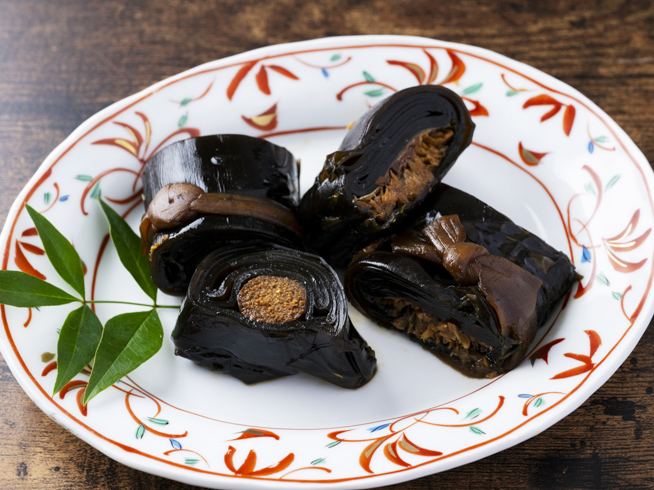Kobumaki (Kelp rolls) | Traditional Foods in Japan

Kobumaki (Kelp rolls)

ToyamaKobumaki (Kelp rolls)
Classification (Large)
Seafood
Classification (Small)
Seaweed products
Main ingredients used
Kombu, dried herring, kanpyo
When using downloaded images, please read the "Terms of Use" and clearly state that the source of the image is "Traditional Foods in Japan" by the Ministry of Agriculture, Forestry and Fisheries.
If the photo credits is stated, please include it as well.
Example of description
of the photo credits
Example of description when the photo credits is not stated
Source: "Traditional Foods in Japan" Ministry of Agriculture, Forestry and Fisheries Example of description when the photo credits is stated
Source: "Traditional Foods in Japan" Ministry of Agriculture, Forestry and Fisheries
Photo credits:xxx
Region of inheritance
Throughout the prefecture
Product overview (special characteristics and types)
According to the Ministry of Internal Affairs and Communication’s Statistics Bureau 2024 household survey, households in Toyama City spent an average of 1,618 yen on kombu. This is more than twice the national average of 702 yen, making it the unrivaled “kingdom of kombu.” Although various kombu dishes have been handed down through the years, kobumaki, in which fish or other ingredients are rolled in kombu, has become a staple delicacy for the New Year holiday and other special occasions.
The common type of kobumaki features dried herring. The rolled kelp is slowly simmered in a sweet broth, resulting in a thick but rich and tender texture. The flavors permeate all the way to the herring in the center.
In addition to having zero calories, kombu is rich in calcium, which strengthens bones, potassium, which lowers blood pressure, and alginic acid, which stimulates large intestine activity, and so it is attracting attention as a food with excellent health and beauty benefits.
History and culture
Although 90% of Japan’s kombu is produced in Hokkaido, its high consumption rate in Toyama, making it the “kingdom of kombu,” is mainly due to the influence of the Kitamaebune ships that were responsible for maritime trade during the Edo period. These ships frequently traveled the Kombu Road route spanning from Hokkaido, the Sea of Japan coast, and Satsuma. In exchange for selling Toyama’s rice, cotton textiles, and sake in Hokkaido and coastal regions, the ships brought back kombu, herring, herring fertilizer, salmon, trout and other seafood. Kombu was purchased in large quantities and brought in from major ports such as Higashiiwase (Toyama City), Fushiki (Takaoka City), and Mizuhashi (Toyama City) to be consumed throughout the region.
Around the mid-Meiji era, many Toyama residents moved permanently or as seasonal workers to Hokkaido’s Kushiro and Nemuro, in search of a stable income. In particular, 70% of those living in the kombu production area of Rausu had ties to Toyama Prefecture. These individuals brought back kombu and dried herring when they returned to Toyama, and spread the kobumaki dish itself.
Kombu had long been regarded as a lucky ingredient, due to it sounding similar to the Japanese word for joy (yorokobu). It is also written as yoro-kombu (養老昆布) which expresses the wish for longevity, along with kobu (子生), which signifies family prosperity. Furthermore, herring (nishin) can also be written as nishin (二親), wishing for fertility and family prosperity. With both ingredients having such meanings, kobumaki became an essential dish for special occasions such as New Year’s Day.
Production method
Dried, filleted herring that has been reconstituted with water are rolled in kelp that has been softened by soaking in water. The rolled products are then tied with kanpyo before they are arranged in a pot and simmered in water until tender. Next, seasonings such as soy sauce and sugar are added and the dish simmers for approximately one hour to allow the flavors to be fully absorbed.
In addition to herring, ingredients such as sardines, yellowtail, salmon, cod roe, and firefly squid can also be used for kobumaki.
Conservation and succession efforts
There are many stores in Toyama Prefecture that offer kobumaki, such as supermarkets and grocery stores, making it easy to obtain. Furthermore, it has established itself as a New Year’s staple and many families have passed down their kobumaki recipes through generations. In recent years, more products featuring variations of fish are being produced, and many purchase the dish as a souvenir or gift.
Main consumption method
Kobumaki is usually cut into pieces that are easy to eat. It is commonly enjoyed as a side dish with rice or as an appetizer with alcoholic beverages.
Contact
Food Cultures Office, Overseas Market Development and Food Cultures Division, Food Industry Affairs Bureau, Ministry of Agriculture, Forestry and Fisheries
Tel:+81-3-3502-5516




